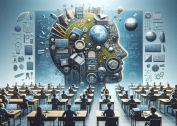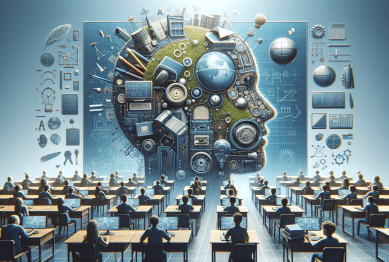Explore how bilingual education impacts cognitive development, career potential, and social skills for all ages. This in-depth guide uncovers surprising benefits, real challenges, and what research reveals about learning in two languages.
Understanding Bilingual Education and Its Foundations
Bilingual education refers to the use of two languages in teaching academic content, providing students with the opportunity to develop proficiency in more than one language. This approach can take many forms, from immersion programs where instruction alternates between two languages, to dual-language models that offer equal exposure. The core objective is not just language acquisition, but also fostering academic achievement and cross-cultural understanding. Incorporating bilingual theory and second language acquisition strategies, educators create classrooms where students learn subject matter while practicing two languages. The term covers everything from elementary school Spanish-English classes to advanced bilingual international schools, making it widely relevant in global conversations about educational inclusion.
The historical roots of bilingual education extend into ancient civilizations, but momentum has grown with globalization and increased migration patterns. As classrooms become more diverse, so does the push to develop language-rich environments that support heritage speakers and newcomers alike. In the United States, landmark policies such as the Bilingual Education Act set the stage for public support and federal involvement. Internationally, countries like Canada and Luxembourg have several decades of formal bilingual or trilingual schooling, creating comparative data. Stakeholders include families seeking to preserve cultural identities, administrators aiming to raise test scores, and policymakers balancing social cohesion with individual rights.
Bilingual curricula frequently integrate cultural materials, recognizing that language and identity are closely linked. Daily instruction may alternate between languages, or use language-specific blocks for various subjects. Teachers skilled in bilingual methodologies tailor their lessons to scaffold learning for mixed-language students, often using visual aids, group work, and culturally relevant texts. By normalizing multilingualism in the classroom, these educational models foster greater tolerance and adaptability. As such, bilingual education not only serves linguistically diverse populations but also prepares monolingual students for life in an interconnected society.
The Cognitive Benefits of Learning in Two Languages
Research repeatedly highlights the cognitive benefits associated with bilingual education. Children and adults who are proficient in more than one language often demonstrate advanced problem-solving skills, better memory, and enhanced attention spans. The process of switching between languages, a phenomenon known as code-switching, is thought to strengthen the brain’s executive control system. These cognitive mechanisms help bilingual individuals ignore distractions, multitask effectively, and adapt to new environments quickly. In studies comparing monolingual and bilingual students, bilinguals typically excel in tasks requiring cognitive flexibility, pattern recognition, and even creative thinking. Exposure to two languages has also been linked to delaying the onset of cognitive decline in older adults (Source: https://www.nichd.nih.gov/health/topics/bilingualism).
One fascinating aspect is metalinguistic awareness—the ability to reflect on and manipulate the structures of language itself. Bilingual students often exhibit a keener sense of grammar and syntax, not just in their second language, but also in their mother tongue. This heightened awareness can spill over into reading comprehension, analytical reasoning, and academic achievement in areas like math and science. The skills gained through bilingual instruction aren’t limited to language arts; instead, they contribute to a neurologically enriched learning environment that supports overall academic growth.
The cognitive advantages appear regardless of the specific language pair, age of acquisition, or socioeconomic status. While earlier exposure generally leads to stronger outcomes, even late learners reap benefits. Bilingual education has thus drawn attention from parents seeking holistic brain development opportunities for their children. Ongoing research continues to explore how bilingualism affects executive functioning across the lifespan, but the consensus remains: developing two languages enhances the mind in nuanced and lasting ways.
Bilingualism and Career Opportunities in a Globalized World
Fluency in more than one language opens doors within an increasingly interconnected global job market. Bilingual professionals tend to have an edge when pursuing roles in diplomacy, business, education, healthcare, and technology. Sectors like international trade, translation, and customer relations highly value candidates who can communicate with diverse populations. Beyond language skills, employers recognize the strategic thinking and adaptability cultivated by bilingual education. Data from labor studies show that bilingual employees often earn higher salaries and have greater mobility across international markets (Source: https://www.actfl.org/center-assessment-research-and-development/what-the-research-shows).
Bilingualism can also influence entrepreneurial opportunities. Business owners who can communicate directly with global partners and clients bridge gaps in negotiations and product development. In healthcare settings, practitioners fluent in multiple languages serve wider communities and can provide better patient care. The ability to shift between languages minimizes misunderstandings, helping professionals offer culturally relevant solutions that build trust. Major tech firms likewise list bilingual proficiency as a key asset for roles in UX design, development, and support, reflecting the digital economy’s cross-border demands.
Educational researchers note that bilingual programs often foster leadership qualities and intercultural competence, traits vital for navigating multinational teams. Those who have learned in two linguistic frameworks are adept at switching perspectives and mediating across cultural lines. These soft skills can be as valuable as technical expertise, driving innovation and collaborative problem-solving. Bilingual education is thus positioned as both a personal and professional investment with lifelong dividends extending well beyond language mastery.
Challenges and Misconceptions Surrounding Bilingual Learning
Despite the advantages, myths and challenges surround bilingual education. One common concern is that learning two languages may lead to confusion or slower language development, particularly for young children. Decades of research, however, indicate that such fears are largely unfounded. Most bilingual individuals acquire both languages to a high level of fluency, and any temporary delays in vocabulary are quickly outpaced by long-term gains in linguistic and mental flexibility (Source: https://www.cdc.gov/ncbddd/childdevelopment/positiveparenting/bilingual-children.html).
Another misconception involves the belief that bilingual education undermines mastery of academic content or erodes cultural identity. In practice, well-designed bilingual programs tend to support higher test scores and reinforce cultural pride. Students learning subject matter in two languages often outperform their peers in monolingual curricula, particularly in mathematics and critical reading. Far from diluting cultural ties, bilingual classrooms often highlight and celebrate heritage traditions, building stronger self-esteem and cross-cultural skills among students from all backgrounds.
The biggest logistical barriers often stem from limited resources, such as shortages of trained bilingual teachers, insufficient funding, or lack of appropriate instructional materials. Political debates about language policies can also affect the availability and structure of programs. Some communities worry about language dominance and shifting linguistic landscapes. These concerns can be addressed through clear communication, community engagement, and evidence-based program design. With thoughtful implementation, the positives of bilingual education consistently outweigh the drawbacks.
Bilingual Education’s Role in Social Development and Cultural Identity
Bilingual education shapes more than academic achievement; it also influences social-emotional growth and cultural identity. By learning content in two languages, students are introduced to diverse worldviews, narratives, and historical experiences. This exposure cultivates empathy and curiosity about different cultures. Programs often incorporate community elders, cultural festivals, and literature from both linguistic traditions—helping students understand and appreciate where they come from and where others do, too.
Social scientists note that students in bilingual classrooms develop strong communication and conflict-resolution skills. Engaging with peers in multiple languages requires adaptability and patience, skills that easily transfer to other social settings. Multilingual environments encourage students to mediate misunderstandings and foster inclusivity. Research also links bilingual education with higher self-esteem and better emotional regulation, as students are given tools to articulate complex thoughts and feelings in both tongues (Source: https://www.colorincolorado.org/article/why-bilingual-education).
For families and communities, bilingual programs can be a lifeline for preserving endangered languages or reconnecting young people to ancestral roots. As migration and digital connectivity blur borders, the ability to communicate across linguistic lines is increasingly invaluable. Bilingual education thus supports not only academic and cognitive growth, but also intercultural understanding and stronger, more compassionate societies. As the world grows more multilingual, the skills developed in these classrooms may well become essential for civic participation and global citizenship.
Designing Effective Bilingual Programs: What Works?
Creating a successful bilingual education program requires careful planning, research-based methods, and ongoing support for teachers and students. Effective curricula offer balanced exposure to both languages, integrate content learning with language instruction, and engage families as partners. Schools that invest in professional development for bilingual educators report higher student achievement and satisfaction rates. Collaboration among teachers, curriculum designers, and community leaders helps tailor programs to local linguistic and cultural realities.
Innovative teaching strategies make a difference. In-class scaffolding—including visuals, structured peer interactions, and formative assessments—supports students with varying language backgrounds. Technology also brings new opportunities, from multilingual e-books to interactive learning apps. Consistency is key: when students receive regular, meaningful exposure to both languages across different subjects, their skills flourish. Advocacy organizations and research networks play a crucial role in sharing best practices, building momentum for bilingual education at policy and grassroots levels (Source: https://www.cal.org/resource-center/briefs-guides/bilingual-education).
Evaluating outcomes and making data-driven adjustments ensure that bilingual programs remain effective and inclusive. Some schools use student portfolios and language proficiency frameworks to track progress, while others engage families in curriculum design. The flexible nature of bilingual education means that programs can be customized to meet a wide range of community needs, from supporting newcomers to revitalizing indigenous languages. Investing in high-quality bilingual education is ultimately an investment in the cognitive, social, and cultural capital of both individuals and societies.
References
1. National Institute of Child Health and Human Development. (n.d.). Bilingualism. Retrieved from https://www.nichd.nih.gov/health/topics/bilingualism
2. American Council on the Teaching of Foreign Languages. (n.d.). What the Research Shows. Retrieved from https://www.actfl.org/center-assessment-research-and-development/what-the-research-shows
3. Centers for Disease Control and Prevention. (2022). Positive Parenting Tips for Bilingual Children. Retrieved from https://www.cdc.gov/ncbddd/childdevelopment/positiveparenting/bilingual-children.html
4. Colorín Colorado. (n.d.). Why Bilingual Education? Retrieved from https://www.colorincolorado.org/article/why-bilingual-education
5. Center for Applied Linguistics. (n.d.). Bilingual Education: What the Research Tells Us. Retrieved from https://www.cal.org/resource-center/briefs-guides/bilingual-education
6. Migration Policy Institute. (2021). The State of Bilingual Education. Retrieved from https://www.migrationpolicy.org/article/state-bilingual-education









